What is cellular respiration?
1 Answer
Respiration is the process of producing energy from glucose.
Explanation:

Cellular respiration occurs in the mitochondria of cells and provides the cells with the energy they need to carry out all of it's functions. It uses glucose and oxygen to give water, carbon dioxide and energy (this making it exothermic).
Cellular respiration is almost always aerobic (in the presence of oxygen) but occasionally, during vigorous exercise, anaerobic may be relied on. This is a less efficient way, as instead of fully breaking the glucose down into water and carbon dioxide, it is only partially broken down into lactic acid. This produces less energy and can lead to an oxygen debt (where breathing and heart rate increases to oxidise the lactic acid).
It might be worth mentioning that the energy is produced in the form of a molecule called ATP, or adenosine triphosphate. This acts like the energy currency of the body, and you have to use a little ATP to produce it in the first place! This sounds very confusing, but is explained in great detail in the video below.
I hope this helps, let me know if I can do anything else:)
